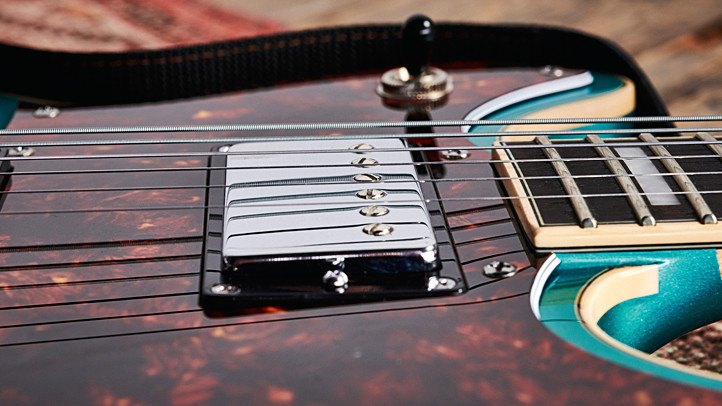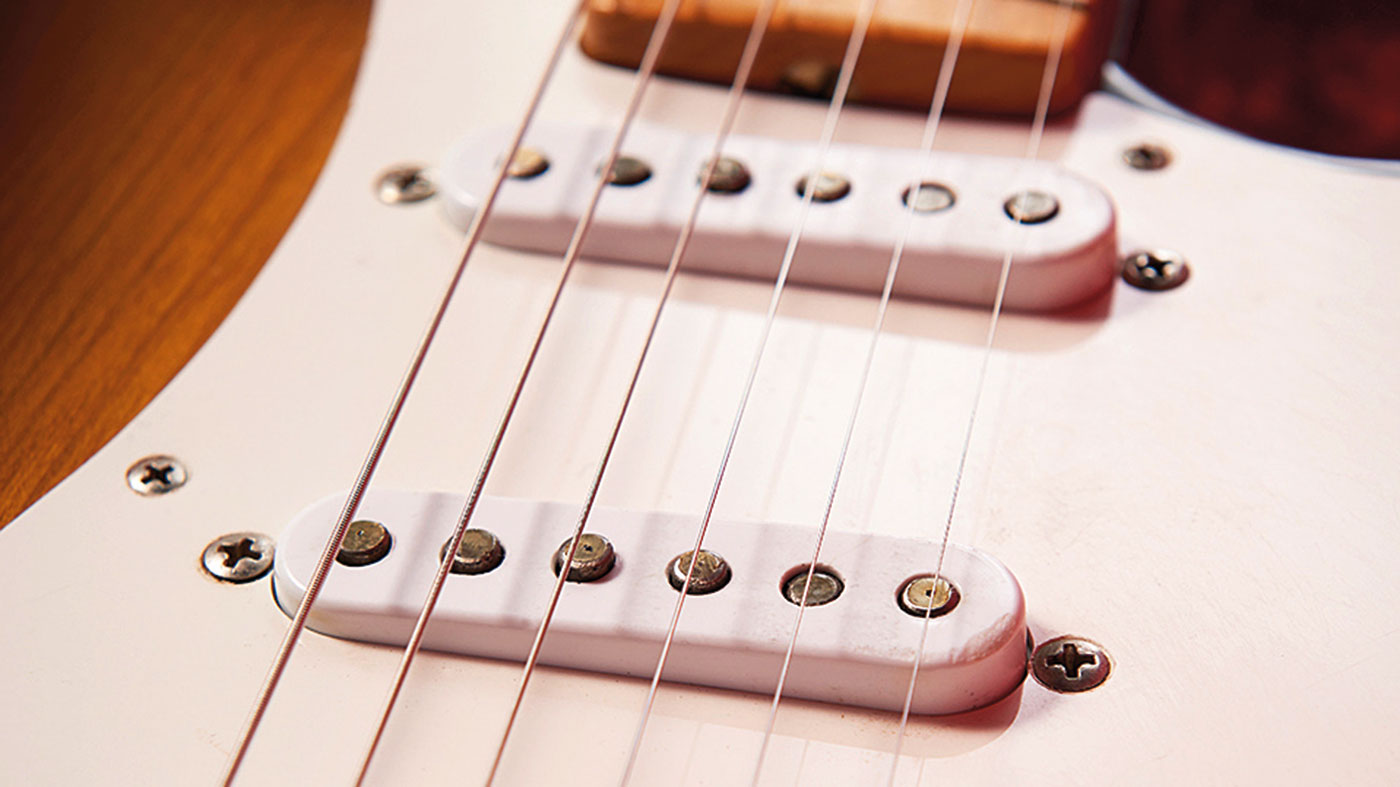
You can make huge positive changes to your sound for free or with reasonable investment. Here’s how…
1. Get a bigger sound
Try a wet/dry amp setup

If you have two amps this can be a fantastic way to supersize your guitar sound; splitting your signal to send some effects to one amp.
We’d advise splitting after your drive pedal/s. Send one split to the first amp (this will be your ‘dry’ amp) and the other split through the effects placed after the drive pedals (modulation and time-based like delay and reverb) to the second amp (this is your ‘wet’ amp).
It’s really a best of both worlds scenario because amp one is direct and dynamic, while the second adds more ambient textures. No matter what amps you’re using they need to be isolated electrically to avoid any ground loop hum and in-phase. An AB/Y box with a built-in polarity reverse switch from brands such as Radial or Lehle can help with the latter.
2. Cut through
Use a clean boost or EQ

You need a cut through for a lead or break so what do you do – add gain? Crank the volume? Gain can be an issue of diminishing returns because the more you add, the more clarity and headroom you lose through compression. Not good.
Want all the hottest music and gear news, reviews, deals, features and more, direct to your inbox? Sign up here.

The best compressor pedals: how to make your clean tones really stand out
And volume can be a bludgeon unless you’re thinking about how you shape it. The solution is simple; use a clean boost or EQ pedal and take the bass level down a notch and increase the upper mids and treble. Now we’re cutting through!
3. Get more headroom
Put your amp’s effects loop to use

Let’s start at the beginning here, what does an amp’s effects return loop (if yours has one) actually do? It bypasses the amp’s front end preamp; your amp’s onboard tone controls are no longer in use allowing you to use only your own choice of preamps, boosts and drives.
There are some significant advantages to doing this; if you’re finding that using those drives through the amp’s own preamp is maxing its headroom and using a drive just brings more gain and not volume, it can get you back to that boost situation for solos. Or just a permanent source of tone. That is, if you’re not then maxing the power amp’s headroom too.
We’ve also seen some superb valve-powered preamp pedals emerge in recent years; making the boutique tones of makers like Victory more affordable. And portable too – you can take your preamp-loaded board and plug into any amp with an effects loop.
4. Get your pickup height right
Setting up your pickups matters

It’s important that pickups are adjusted to the right height to realise your guitar’s full tonal potential. But while they’ll sound louder the closer to the strings you raise them, that doesn’t always mean better…
Humbuckers

Humbuckers can sit as close as you want to the string for the volume you want. But beware of wolf notes that can occur when the pickup’s magnetic field is too close to the string’s field of movement, preventing it from vibrating naturally. Start the adjustment process by fretting the top and bottom E strings at the final fret. Using a steel rule, adjust the humbucker’s height until its treble and bass sides both sit evenly 2.5mm beneath the fretted strings.
Single-coils

Strings vibrate more freely near the neck than they do at the bridge
Strat-style single-coil guitars should be adjusted to sit with the treble side slightly higher than the bass for a good tonal balance. Fret the two outer strings at the final fret, then adjust the pickups so the polepiece tops sit 2.5mm and 3.5mm from the treble and bass E strings respectively.
Strings vibrate more freely near the neck than they do at the bridge, meaning neck pickups sound louder for a given height – though many companies now calibrate pickups sets with this in mind. A little experimentation with relative height settings may be necessary to establish a good balance in volume between pairs or trios of pickups.
In our experience, medium output dogear P-90 single-coil pickups will often respond well to being raised closer to the strings that you might expect. This type of pickup can't be raised with the usual screwdriver method so you'll need to make or invest in a card, wood or plastic shim to fit under the P-90 and physically raise the P-90 closer to the strings.
5. Pair boost with overdrive
Boost your drive and drive your boost

Generally, placing your overdrive pedal before a clean boost can give you more picking dynamics and clarity for low to medium gain sound
So is it best to boost your overdrive by placing it before in the signal chain or driving your clean boost by placing it after? Each offer different strengths and it’s of course dependent on what units you’re using but generally, placing your overdrive pedal before a clean boost can give you more picking dynamics and clarity for low to medium gain sounds.
If you have the amp headroom, boosting after your overdrive can also offer a good boost for solos. If you want more overdrive, compression and less of a volume boost into your amp, place the boost before the overdrive. Give it a try!
6. Get better tone at bedroom volumes
A compressor is your friend

A big guitar sound is a dynamic one – so it’s really a matter of enhancing with pedals to replicate what a valve amp does when it’s cranked. Using a compressor for rock and blues can reduce the attack of notes at the start and add sustain in their decay. A boost will push the front end of the amp at lower volumes too.
7. Upgrade your guitar hardware
The quality of your hardware matters more than you think

Your saddles, bridge and nut material affect your tone
String travel and vibration are crucial to how well your guitar performs, second to your hands in the signal chain. An acoustically resonant guitar can also be a more inspiring thing to play. And it's the result of a combination of factors. Your saddles, bridge and nut material affect your tone with brass, steel and alloy offering a different response to the string in their attack and sustain.
Even the guitar’s baseplate and vibrato block can have an impact. Steel can sound brighter than other metals and a bone nut and saddle on an acoustic can improve sustain and brightness over manmade plastics.
It can be relatively cheap to upgrade and experiment with new components too. But we'd especially advise nut fitting and cutting to be handled by a professional. Get it wrong and it's difficult to undo. A well-cut guitar nut by a pro is a wise investment.
Try different string and pick gauges
You don't have to get stuck in a buying habit

So many of us guitar players are creatures of habit with our guitar accessories – returning to the same model guitar picks, same gauge strings. But do we really know what we might be missing out on?
Opting for a light gauge string or heavier gauge pick can suddenly make the integral experience of playing, touch and sound very different. Then there are materials – there’s a very different feel between nylon and Tortex picks, while stainless steel electric guitar strings can sound brighter than the usual nickel-steels.
There’s a lot of choice out there, and for acoustic players especially there’s often a string model waiting to be found that will feel like the perfect match for your guitar.
9. Save your tone!
Your choice of cable is important

The general rule is, the longer your cable length is, or the more capacitance the cable itself has for its given length, the more loss of high-end you’ll notice
Before you consider upgrading your guitar cable it’s best to know why and how guitar cables matter…
Will buying a better cable improve my guitar tone?
It can definitely change it, though you’ll feel the effects of different cables much more if you use passive pickups rather than active. This is where capacitance comes into play – a buzzword around guitar cables for a very good reason.
Capacitance has the most noticeable effect of reducing high-end treble frequencies in your tone – but it can actually have an effect across the spectrum. Combined with the inductors that are your guitar pickups, it can actually add midrange gain. The general rule is, the longer your cable length is, or the more capacitance the cable itself has for its given length, the more loss of high-end you’ll notice.
You may even want this but if you’re lacking some high-end brightness, low capacitance cable could make a positive difference to your sound.

What is capacitance?
A capacitor is formed between two electrical conductors that are in close proximity – and the larger the surface area of these conductor (in your guitar cable) then the larger the capacitance. Large amounts of capacitance are measured in units of farads, named after 19th century English physicist Michael Faraday.
The smaller amounts found in guitar cables are measured in picofarads (pf); each one million-millionth of a farad. A decent quality audio cable should offer 30pf per foot with the highest quality offering around half that.

Best guitar cables, featuring leads and patch cables to suit all budgets
Why aren’t active pickups effected by cable capacitance?
Active pickups contain a preamp that offsets any issues with impedance by converting it to low impedance; and it can drive a cable without any loss of high frequency.
What is impedance?
Impedance (Z) is the measure of the total opposition to current flow in an alternating current circuit. It is made up of the sum of two components, resistance (R) and reactance (X). Sounding technical? Stay with us for the important bit…
The output from most electronic audio devices is usually low impedance (around 150ohms) but it can be much higher for passive guitar pickups. And this means it is more adversely affected by capacitance from a cable to create a filter on your sound – as capacitance and impedance go up, this filter comes into effect more. In theory, the ideal setup for wide frequency response in your tone is a low impedance pickup and low capacitance cable.

What about the patch cables between my pedals – is their capacitance important?
Patch cable capacitance isn’t as important as the cable that goes between the guitar and the first pedal in your chain because pedals have low impedance outputs. Though if your pedals are true bypass, and many are nowadays, they will have more effect on the overall capacitance in our signal. One reason why Klon designer Bill Finnegan prefers buffer output.
7 ways to improve your rhythm guitar tone

Rob is the Reviews Editor for GuitarWorld.com and MusicRadar guitars, so spends most of his waking hours (and beyond) thinking about and trying the latest gear while making sure our reviews team is giving you thorough and honest tests of it. He's worked for guitar mags and sites as a writer and editor for nearly 20 years but still winces at the thought of restringing anything with a Floyd Rose.
